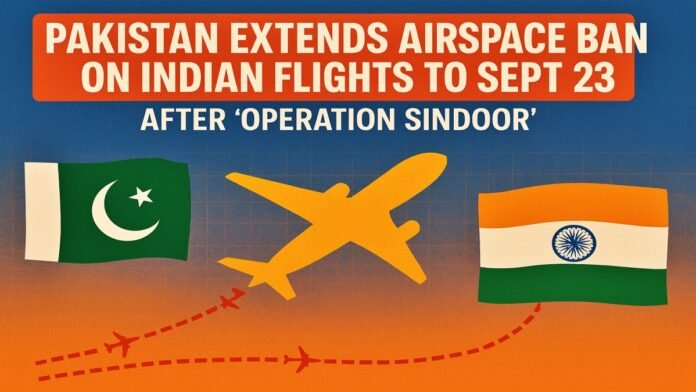
Key Points
- Pakistan extends ban on Indian aircraft over its airspace to September 23; applies to state-owned, leased, military, and civilian aircraft.
- New NOTAM reiterates restrictions first imposed after April 23 Pahalgam terror attack escalation.
- Ban follows India’s ‘Operation Sindoor’ targeting terror hideouts in Pakistan and Pakistan-occupied Kashmir (PoK).
- Pakistan reportedly facing heavy revenue loss due to reduced overflight fees; air traffic down sharply.
- China urges India–Pakistan rapprochement, offers mediation; move may complicate any dialogue.
New Delhi: Pakistan has extended the prohibition on Indian aircraft transiting its airspace until September 23 through a fresh NOTAM, maintaining curbs that began amid heightened tensions this summer. The restriction covers all Indian carriers and includes aircraft leased by Indian operators, as well as military and civilian flights, effectively shutting a key westbound corridor for Indian-origin operations.
How We Got Here: Timeline of Escalation
- April 23: A terror attack in Pahalgam intensified cross-border tensions, prompting a month-long reciprocal clampdown across various domains.
- May 7: India launched ‘Operation Sindoor’, a sustained, targeted action against terror infrastructure inside Pakistan and PoK.
- Subsequent days: Pakistan conducted retaliatory strikes; India responded, with hostilities spanning roughly four days before a ceasefire dynamic resumed.
- Since then: Pakistan has kept its airspace restrictions in place for Indian aircraft, renewing them via NOTAMs, and has now pushed them to September 23.
The Airspace Ban: Scope and Impact
- Coverage: The NOTAM prohibits overflight and entry by aircraft belonging to Indian airlines, including leased frames operated on Indian AOPs, and extends to both civilian and military aircraft tied to India.
- Operational impact: Indian long-haul routes that would typically cut across Pakistan must continue to use longer detours over the Arabian Sea/Iran or Central Asian corridors, increasing block time, fuel burn, and costs.
- Regional effect: Non-Indian carriers that overfly Pakistan remain permitted under their own arrangements, but any code-shares or wet-leases involving Indian operators are affected where applicable.
Economic Fallout for Pakistan
- Overflight revenue loss: With daily international overflights reduced, Pakistan’s aviation authorities face a sizable decline in route navigation and overflight fees.
- Reported figures indicate losses crossing the ₹1,240 crore mark over roughly two months of restrictions, driven by the drop in transit charges that airlines pay per crossing.
- Broader drag: A sustained 20% decline in air traffic has downstream effects on airspace management revenues and ancillary aviation services.
Geopolitical Overlay: China’s Position
- Beijing has publicly encouraged improvements in India–Pakistan relations and indicated willingness to facilitate dialogue.
- Pakistan’s extension of the airspace ban hardens the negotiating atmosphere and could slow any backchannel or formal talks in the near term.
What to Watch Next
- September 23 review: Whether the NOTAM lapses, is narrowed (e.g., civilian-only carve-outs), or extended again.
- Route economics: Sustained detours may nudge Indian carriers to tweak frequencies, aircraft rotations, or ticket pricing on Europe/Middle East/Africa sectors if winds and fuel trends turn unfavorable.
- Diplomatic signaling: Any CBMs (confidence-building measures), hotline engagements, or third-party nudges especially from partners with stakes in regional connectivity.
Traveler Advisory
- Expect potential schedule padding on westbound long-haul services originating in India.
- Monitor airline notifications for minor timing shifts; significant reroutes are already in place and reflected in timetables.
- Cargo operators may adjust routings and yields; shippers should check updated transit times.
Advertisement





















































